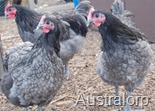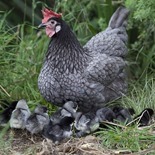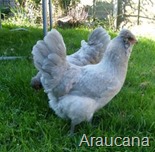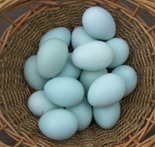 After trying for a year we have finally cracked it ! We now have heritage chicken breeds in Tuvalu !
After trying for a year we have finally cracked it ! We now have heritage chicken breeds in Tuvalu !
Tuvalu has lots of chickens, but most of them are ‘local’ bantam-sized mixed birds of uncertain heritage. They are probably a mix of the original chickens brought to the islands, plus odd injections of project chickens brought to establish farms of commercial meat or egg birds in the past. The mixed local chickens are poor egg-layers (maybe 50 eggs a year per bird) and are very small (though tasty !) to eat. These are in stark contrast to the few Hyline Browns brought in from Fiji and which are commercial egg-layers capable of producing up to 330 eggs per year per bird (best case) but from which we cannot reproduce.
We know, for example, that Black Australorps were brought in in the 1980’s as part of a chicken improvement project, but through interbreeding with the local birds, have disappeared into the bantam mixture. Bringing in new heritage breeds of birds was done to introduce some breeds that are excellent egg-layers (250-300 eggs per bird per year) that could be used to breed more birds true to their type. The idea is for each family to keep around 6 birds to meet at least some of their egg needs, and be able to propagate new egg-layer birds as needed. Although not able to lay as many eggs as the Hylines, certain heritage breeds are pretty close and have the advantages of being able to ‘go clucky’, rear their own chicks and forage for food. They probably live in the atoll conditions better than the commercial breeds, being more adaptable and longer-lived.
The new breeds were sourced in Australia from registered breeders and went through rigorous biosecurity requirements in Australia, Fiji and Tuvalu to be able to get here. They were brought as eggs, which we turned several times a day during transit, and ensured they were kept cool and with good access to air so they could breathe. Once they arrived in Tuvalu we let them sit for almost 24 hours to settle with wide end up before putting them in incubators to hatch in 21 days. The hatch rate was a lot lower than you would expect from locally sourced eggs – the trip itself is very hard on them. In the end we got 18 babies from 43 eggs (42% hatch) – which seems to be a small miracle in itself, given it has taken us 3 attempts to get a decent hatch. The breeds are: Australorp and Araucana, which we will breed from in May 2016 onwards, plus a few extras which are Anconas and Light Sussex.
Australorp
 Australorps were developed in the 20th century in Australia, primarily from the Orpington breed. They became famous when one hen in the 1920s laid a record 364 eggs in 365 days ! The birds we have are blue and black. These are great egg-layers and have a warm, peaceful temperament. The birds are hardy in hot and cold weather and can live in high humidity. They lay extra-large brown eggs, and many of them, around 250-300/year, starting at about 5 months of age. They are great all-purpose birds, being good for eggs, meat and even pets.
Australorps were developed in the 20th century in Australia, primarily from the Orpington breed. They became famous when one hen in the 1920s laid a record 364 eggs in 365 days ! The birds we have are blue and black. These are great egg-layers and have a warm, peaceful temperament. The birds are hardy in hot and cold weather and can live in high humidity. They lay extra-large brown eggs, and many of them, around 250-300/year, starting at about 5 months of age. They are great all-purpose birds, being good for eggs, meat and even pets.
Araucana

 Actually, these should be called Easter-eggers (EE) as true Araucanas are rare. The Araucana breed was developed in Chile from a cross between the Collonca and the Queteros blue egg-layers. EEs are hybrids. They are very friendly birds and great egg-layers (5-6 eggs per week), and are considered dual-purpose (meat and eggs). The extra bonus with these is that their eggs are blue coloured, though do not worry they look normal inside. The birds are good foragers, and have cute tufts (feathers on the side of their cheeks) that make them look very distinctive. They are light birds and do not eat very much
Actually, these should be called Easter-eggers (EE) as true Araucanas are rare. The Araucana breed was developed in Chile from a cross between the Collonca and the Queteros blue egg-layers. EEs are hybrids. They are very friendly birds and great egg-layers (5-6 eggs per week), and are considered dual-purpose (meat and eggs). The extra bonus with these is that their eggs are blue coloured, though do not worry they look normal inside. The birds are good foragers, and have cute tufts (feathers on the side of their cheeks) that make them look very distinctive. They are light birds and do not eat very much
Ancona
This is a medium-sized breed developed in Italy in the mid 19th Century. Anco nas are eggzellent egg-layers (300 eggs/year) and begin laying early (around 17 weeks of age). They have yellow skin and legs and black, mottled feathers. These birds lay large white to light cream eggs and don’t eat too much food. They love to forage for their own bugs to eat and are good at escaping predators (dogs, cats, rats) and are good flyers (for chickens, that is). These are a bit more flighty than other breeds, but they are friendly if kept in a calm place. They are considered good in hot climates.
nas are eggzellent egg-layers (300 eggs/year) and begin laying early (around 17 weeks of age). They have yellow skin and legs and black, mottled feathers. These birds lay large white to light cream eggs and don’t eat too much food. They love to forage for their own bugs to eat and are good at escaping predators (dogs, cats, rats) and are good flyers (for chickens, that is). These are a bit more flighty than other breeds, but they are friendly if kept in a calm place. They are considered good in hot climates.
Six Chix
Our babies are now about a month old now, so we expect to be able to breed from them by about mid 2016. If you are interested in chicks or eggs to hatch under your own hens, we should have some birds around that time. For 6 chickens you will need a chicken house maybe 1.5m x 1.5m, with nest boxes. And to raise your chicks, you should really get some Chick Starter Crumbles from Pacific Feeds and some Organic Apple Cider Vinegar (with mother) to keep them healthy (see https://tautai.com/not-just-chicken-feed/).
